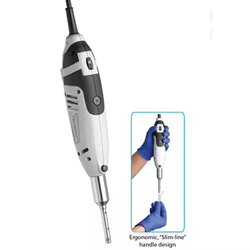Homogenizers
The high quality homogenizers available at NextDayScience meet a wide range of needs and will completely grind, lyse, and homogenize a broad variety of biological samples. The homogenizers work at speeds necessary to fully homogenize-in as little 30 seconds or less. They are able to homogenize all sample types, from soft tissue to bone, and can mix from one to multiple tubes simultaneously. All of our homogenizers are fast, powerful, and efficient, and come in several options to suit your laboratory needs.
4 product(s) found
Considerations To Take Into Account When Selecting Homogenizers
What is a Homogenizer?
Homogenizers are available in different sizes and can be used on a wide range of samples, from small volumes to larger quantities. They can also be made from stainless steel or plastic materials and come with different features like adjustable speeds, automatic stop/start functions, and more.
The Different Types of Homogenizers
There are four main ways to homogenize: ultrasonic, mechanical, pressure, and continuous.
Ultrasonic homogenizers use high-frequency sound waves to break down solids into smaller particles. Mechanical homogenizers use the force of a rotor combined with the shearing action of a stator (a stationary part). Pressure homogenizers use positive or negative pressure to force material through small openings in a chamber. Continuous homogenizers work by continuously moving materials back and forth inside an enclosed chamber as they pass through oversize holes or nozzles at high speeds.
Ultrasonic Homogenizers
Ultrasonic homogenizers are based on the principle of cavitation and the resulting phenomenon, ultrasound. Ultrasound is produced by the ultrasonic generator, which produces an oscillating pressure wave at frequencies of 20 kHz or above.
This pressure wave propagates through the liquid and causes microbubbles to form. When these bubbles collapse, they form high-energy shock waves that cause tiny particles of food to be shattered into much smaller ones.
The benefit of using an ultrasonic homogenizer is its ability to break up materials quickly with minimal heat transfer during operation; it can also maintain particle size over time (unlike most other methods).
Mechanical Homogenizers
Mechanical homogenizers use high speeds to break up particles. This can be done by forcing liquid through a narrow opening, as in the case of hydraulic homogenizers, or by passing liquid over a rapidly rotating blade or disk that shears the particle clusters apart.
A mechanical homogenizer is often used for low-viscosity liquids and at higher speeds than the ones used for emulsification. For example, if you're trying to create an emulsion with water and oil, your best bet would be using a rotor-stator homogenizer rather than an ultrasonic processor; the latter requires very low viscosities (i.e., thinned down fluids).
Pressure Homogenizers
Pressure homogenizers are also known as high-pressure homogenizers. These machines are used to create homogeneous fluid from the starting material, which can be either solid or liquid. The machine works by applying high pressure on the material under study and breaking it down into smaller particles. This results in the creation of a uniform sample that can then be further analyzed or used for other experiments.
High-pressure homogenizers are mainly used by researchers and food scientists to prepare test samples for analysis. The process involves breaking down larger particles into smaller ones so that they resemble each other in size and weight, thereby giving equal representation of each particle type within the sample. This helps them accurately analyze their findings at later stages of their research.
Continuous Homogenizers
Continuous homogenizers are used to create a fine emulsion, which is the process of dispersing small droplets throughout a substance. These machines have a high shear rate, which means that they can break down large particles into smaller ones very quickly. They are also used to homogenize liquids with a high viscosity (thickness). This makes them ideal for use in the food industry, as well as in the pharmaceutical and cosmetics industries.
Short-Term Homogenizers
Short-term homogenizers (STHs), also known as high-pressure homogenizers, are a specific type of homogenizer used for short-term (or "low rate") homogenization. The purpose of an STH is to rapidly increase the surface area of a liquid in order to break apart and disperse large particles within it. This is often done using high pressure and speed to ensure that only small quantities are processed at once; some STHs can process up to 70 liters per minute.
What To Consider When Buying a Homogenizer For Your Lab
When buying a homogenizer for your lab, there are several things that you need to take into account. The most important thing is to find out what type of homogenization you want to achieve. Some processes require complete homogenization while others don't. Also, there are different types of homogenizers available in the market, so make sure that you know which one you need before making any purchase decision.
Another thing that should be considered when buying a homogenizer is its power rating or speed rating. It's important because this tells us how fast our sample will be processed and how much pressure will be applied to it during the process. If you don’t know these things, then you may end up spending more than what was needed, or even worse, you could buy an underpowered unit that won’t be suitable for your desired application.



